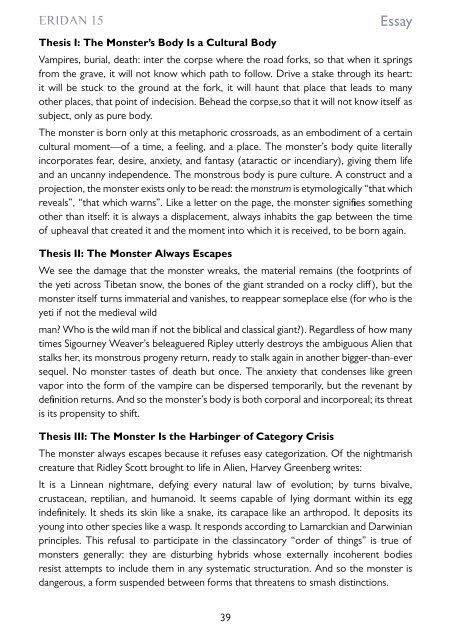Create successful ePaper yourself
Turn your PDF publications into a flip-book with our unique Google optimized e-Paper software.
ERIDAN 15EssayThesis I: The Monster’s Body Is a Cultural BodyVampires, burial, death: inter the corpse where the road forks, so that when it springsfrom the grave, it will not know which path to follow. Drive a stake through its heart:it will be stuck to the ground at the fork, it will haunt that place that leads to manyother places, that point of indecision. Behead the corpse,so that it will not know itself assubject, only as pure body.The monster is born only at this metaphoric crossroads, as an embodiment of a certaincultural moment—of a time, a feeling, and a place. The monster’s body quite literallyincorporates fear, desire, anxiety, and fantasy (ataractic or incendiary), giving them lifeand an uncanny independence. The monstrous body is pure culture. A construct and aprojection, the monster exists only to be read: the monstrum is etymologically “that whichreveals”, “that which warns”. Like a letter on the page, the monster signifies somethingother than itself: it is always a displacement, always inhabits the gap between the timeof upheaval that created it and the moment into which it is received, to be born again.Thesis II: The Monster Always EscapesWe see the damage that the monster wreaks, the material remains (the footprints ofthe yeti across Tibetan snow, the bones of the giant stranded on a rocky cliff), but themonster itself turns immaterial and vanishes, to reappear someplace else (for who is theyeti if not the medieval wildman? Who is the wild man if not the biblical and classical giant?). Regardless of how manytimes Sigourney Weaver’s beleaguered Ripley utterly destroys the ambiguous Alien thatstalks her, its monstrous progeny return, ready to stalk again in another bigger-than-eversequel. No monster tastes of death but once. The anxiety that condenses like greenvapor into the form of the vampire can be dispersed temporarily, but the revenant bydefinition returns. And so the monster’s body is both corporal and incorporeal; its threatis its propensity to shift.Thesis III: The Monster Is the Harbinger of Category CrisisThe monster always escapes because it refuses easy categorization. Of the nightmarishcreature that Ridley Scott brought to life in Alien, Harvey Greenberg writes:It is a Linnean nightmare, defying every natural law of evolution; by turns bivalve,crustacean, reptilian, and humanoid. It seems capable of lying dormant within its eggindefinitely. It sheds its skin like a snake, its carapace like an arthropod. It deposits itsyoung into other species like a wasp. It responds according to Lamarckian and Darwinianprinciples. This refusal to participate in the classincatory “order of things” is true ofmonsters generally: they are disturbing hybrids whose externally incoherent bodiesresist attempts to include them in any systematic structuration. And so the monster isdangerous, a form suspended between forms that threatens to smash distinctions.39


